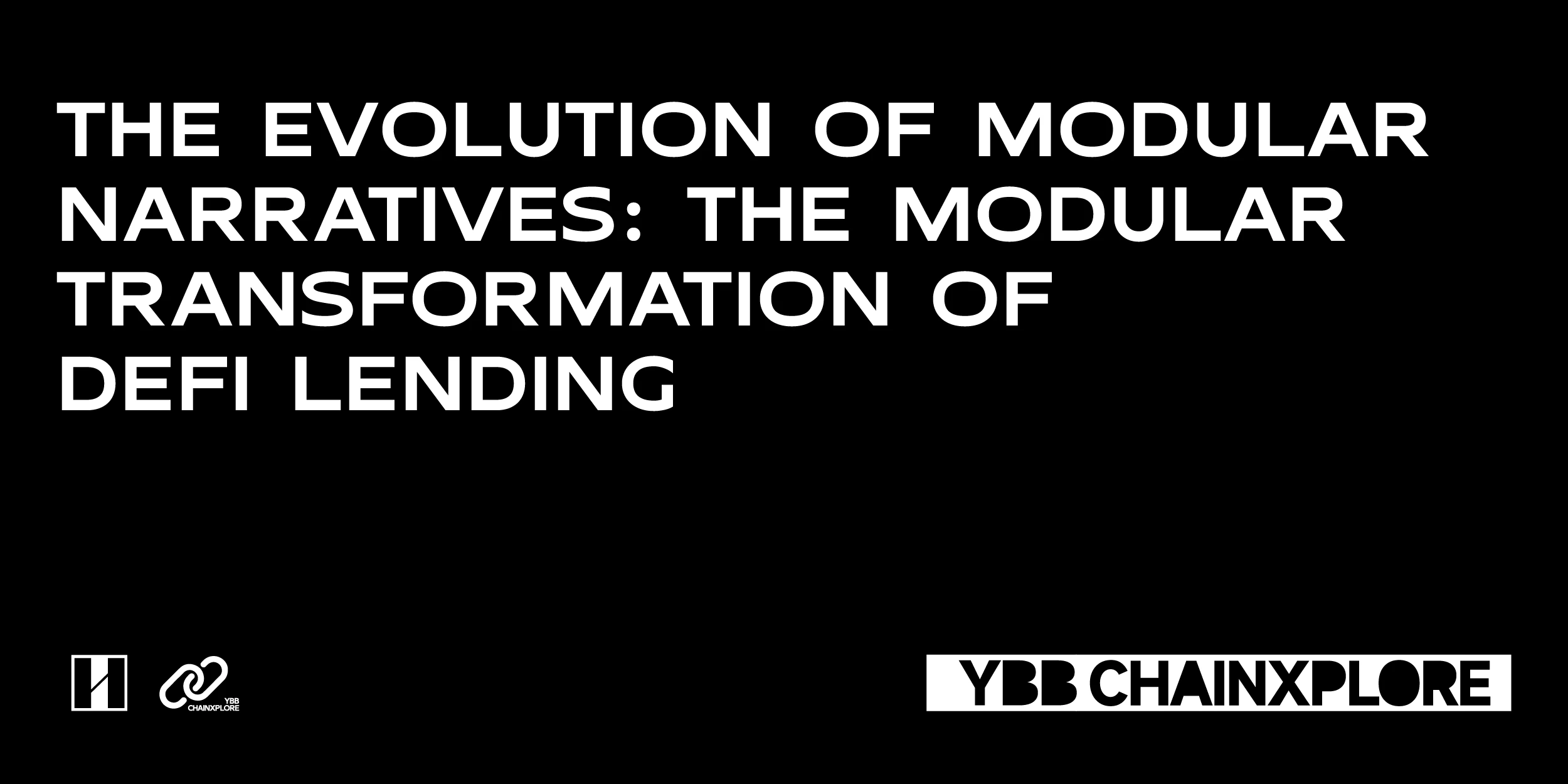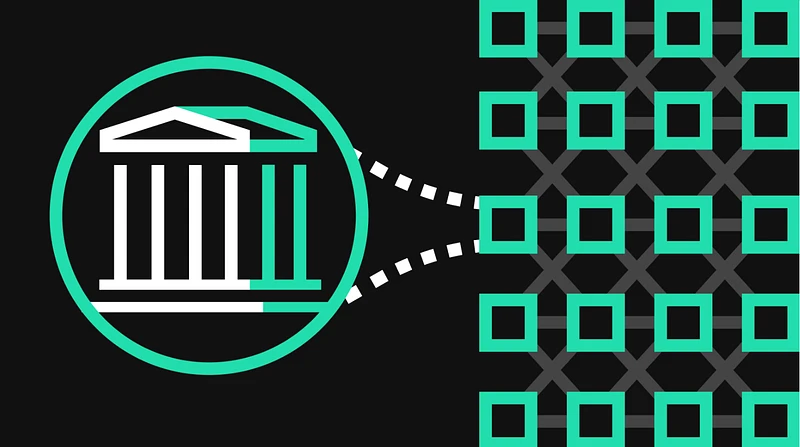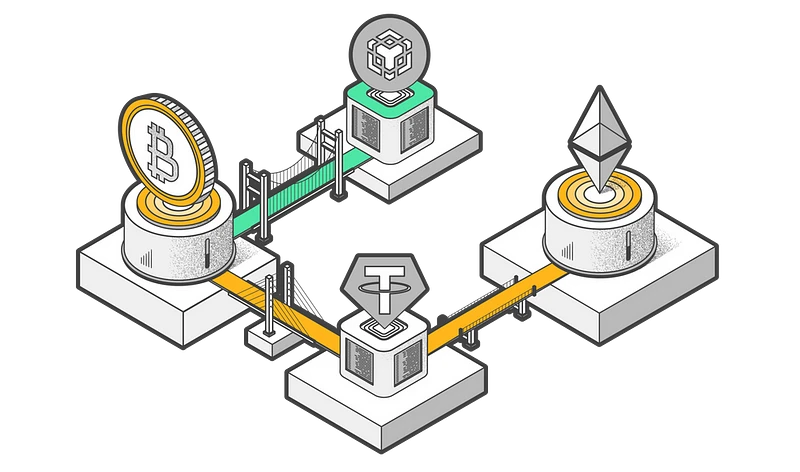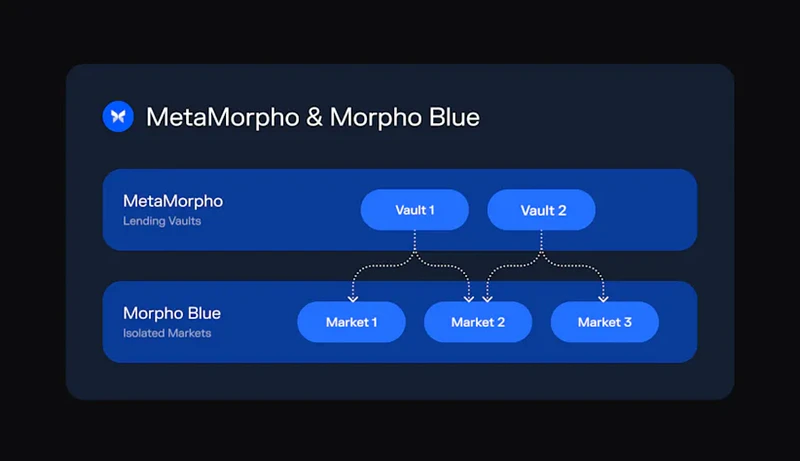원저자 : YBB Capital Researcher Ac-Core
요약
-
모듈러 대출의 본질은 단순히 크로스체인과 집계가 아니라, 둘 다 모듈러 대출에서 중요한 역할을 합니다.
-
모듈식 대출은 기본 계층이 제공하는 보안, 합의, 데이터 가용성을 활용하며 실행 및 애플리케이션 계층의 기능적 모듈화에 초점을 맞춥니다.
-
모듈식 대출은 담보 관리, 이자율 계산, 위험 평가, 청산 메커니즘 등의 여러 독립된 모듈로 프로세스를 세분화하고 표준화된 인터페이스를 통해 모듈 간의 통신을 지원합니다.
-
The characteristics of the current modular DeFi protocol are similar to the logic of OP Stacks one-click chain launch. Deployment requires the establishment of a module combination based on its own protocol to create new financial products and services.
1. The Origin of Modularity
The concept of modular blockchain originated from two white papers. In 2018, Mustafa Albasan and Vitalik Buterin co-authored the paper Data Availability Sampling and Fraud Proofs, which proposed a system that allows light clients to receive and verify fraud proofs from full nodes, and designed a data availability sampling protocol to reduce the trade-off between on-chain capacity and security, solving the scalability problem of blockchain without sacrificing security and decentralization.
Later in 2019, Mustafa Albasan detailed a new architecture in the Lazy Ledger white paper that uses blockchain for ordering and ensuring the availability of transaction data, rather than for the execution and verification of transactions. This new architecture was designed to address the scalability issues of existing blockchain systems and was then called a smart contract client. The execution of smart contracts was carried out on this client through another execution layer, which was the prototype of Celestia (the first modular data availability layer project).
With the emergence of Rollup technology, this concept has become more concrete. Its logic is to execute smart contracts off-chain and upload the results as proof to the execution layer of the client. By reflecting on the architecture of blockchain and new expansion technologies, Celestia was born and defined a new paradigm of modular blockchain.
2. The emergence of modular blockchain
Modular blockchain aims to solve the impossible triangle problem in the blockchain field by decoupling and reorganizing. Simply put, it is to decompose the main functions of a single chain into multiple layers, each layer focuses on implementing specific functions, thereby achieving scalability. Generally speaking, the basic functions of a single chain can be divided into the following four functional layers:
-
Data Availability Layer: Responsible for ensuring that data in the network can be accessed and verified, including data storage, transmission and verification functions, to ensure the transparency and trust of the blockchain network. Currently, representative DA projects include Celestia, Avail, EigenDA, etc. Monolithic public chains such as Ethereum and Solana can also carry DA needs (Bitcoin has no good verification solution for traditional Rollup due to its non-Turing completeness, but the exploration of its expansion capabilities is progressing rapidly);
-
Consensus Layer: Responsible for the agreement between nodes to achieve consistency of data and transactions in the network. Transactions are verified and new blocks are created through consensus algorithms (such as PoW or PoS). Most DA projects also need their own consensus layer, which is usually designed as a light node method with low hardware requirements and simple verification;
-
Execution Layer: Responsible for processing transactions and executing smart contracts, including transaction verification, execution, and status updates. Layer 2 projects (such as Arbitrum, Optimism, and ZKsync) are modular blockchains that only have execution layer functions. They verify the correctness of transactions through the main chain and inherit the security of the main chain.
-
Settlement Layer: Responsible for completing the final settlement of transactions and ensuring that the transfer and record of assets are permanently stored on the blockchain. The main function of the modular settlement layer is to verify the validity proof and status data of Rollup. Well-known projects include Dymension, Cevmos, etc.
In the early history, solutions around Bitcoin such as Lightning Network and sidechain can be seen as pioneers of modularization. However, due to the non-Turing completeness of Bitcoin, these expansion solutions have been slow to progress and have various defects, and have not been widely adopted. Traditional blockchains try to solve the trilemma by reconstructing the underlying framework, but the effect is limited. To solve this problem, Vitalik Buterin proposed a solution around Rollup. With the maturity of fraud proofs and zero-knowledge proofs, the way to use the Lego-style building method to build the execution layer on Ethereum has gradually become a reality, and Ethereum has also determined its final outcome as a layered expansion path around Rollup upgrades. The upgrade method with Rollup as the core is expected to surpass previous expansion solutions and become the ultimate solution for public chain expansion.
3. Modular Derivatives – Modular Lending
Image source: Legend Quant
DeFi modular lending utilizes the security, consensus and data availability provided by the base layer, mainly focusing on the execution layer and application layer for functional modularization, and running these functional modules on the blockchain. Its main modular parts include: collateral management module, which is responsible for storing, managing and processing users collateral to ensure the security and compliance of collateral; interest rate calculation module, which dynamically adjusts the lending rate based on market supply and demand, user credit score and other factors; risk assessment module, which assesses the credit risk of the borrower and decides whether to approve the loan request and the amount of collateral required; liquidation mechanism module, which triggers the liquidation procedure when the borrower fails to repay on time to protect the interests of the platform and other users.
The modular lending system needs to obtain all necessary transaction and contract data from the data availability layer so that modules can interact and verify with each other. The operation results of each module need to be confirmed and recorded by the consensus layer to ensure that the state changes of all modules are safe and consistent. Most of the logic of modular lending runs on the execution layer, and the functions of each module are implemented through smart contracts. The final settlement and clearing of lending transactions rely on the settlement layer to ensure the finality of lending and clearing transactions.
3.1 Core Concept
-
Modular design: The lending process is broken down into multiple independent modules, such as collateral management, interest rate calculation, risk assessment, and liquidation mechanism. Each module can be independently developed, tested, and deployed;
-
Interoperability: Modules communicate with each other through standardized interfaces, which makes it easy to combine different modules and even use some modules across platforms;
-
Upgradability: Since each module is independent, a module can be upgraded individually without affecting the operation of the entire system. This feature allows the system to quickly respond to market changes and technological advances;
-
Security: Modular design can isolate risks. For example, if a module has a security vulnerability, only the module needs to be repaired without affecting the entire system.
3.2 Key Components
-
Collateral management module: handles the deposit, withdrawal and management of collateral to ensure the security and compliance of users’ collateral;
-
Interest rate calculation module: dynamically adjusts lending rates based on market supply and demand, borrowers credit score and other factors;
-
Risk assessment module: assesses the risk of the borrower and decides whether to approve the loan request and the amount of collateral required;
-
Liquidation mechanism module: When the borrower is unable to repay on time, the liquidation procedure is triggered to ensure the financial security of the lending platform.
3.3 Advantages
-
Flexibility: Different modules can be combined as needed to meet diverse lending needs;
-
Efficiency: Improve the efficiency of the overall system by optimizing the performance of each module;
-
Innovation: Allows developers to innovate on specific issues and launch new modules to enhance functionality;
-
Transparency: Modular systems have higher transparency, and the operating logic and status of each module can be audited and verified individually.
3.4 The role of cross-chain and aggregation in modular lending
Image source: Cross-Chain Bridges Explained
The essence of modular lending is not just cross-chain and aggregation, although these two play an important role in modular lending. The core concept of modular lending is to improve the flexibility, scalability, security and innovation of the system by modularizing each function in the lending process. Cross-chain and aggregation are part of the core concept of modular lending, but not the only or all of it.
상호 운용성:
-
Cross-chain technology: enables assets and functional modules on different blockchains to interoperate. This is crucial for modular lending because it allows users to transfer assets between different blockchains and utilize various decentralized applications (dApps);
-
Multi-chain support: By supporting multiple blockchains, lending platforms can improve their usability and flexibility, attracting more users and assets.
Aggregation:
-
Aggregation protocol: Aggregate multiple lending protocols and liquidity pools to provide a unified interface and better user experience. For example, users can access multiple lending markets through an aggregation platform to obtain the best lending rate;
-
Liquidity aggregation: Improve capital utilization efficiency and market liquidity by aggregating multiple liquidity sources.
3.5 Other key aspects of modular lending
Modular Design:
-
Functional modularization: decompose the lending process into independent functional modules (such as collateral management, interest rate calculation, risk assessment, and liquidation mechanism). Each module can be independently developed, deployed, and upgraded.
-
Standardized interface: Each module communicates through a standardized interface to ensure compatibility and interoperability between modules.
Security and Risk Management:
-
Risk isolation: Modular design can isolate risks in specific modules. If a problem occurs in a module, it will not affect the entire system.
-
Security Audit: Each module can be audited individually to improve the security of the overall system.
Flexibility and scalability:
-
Flexible combination: Users and developers can flexibly combine different modules according to their needs to adapt to diverse lending needs;
-
Scalability: System functionality and performance can be expanded by adding or replacing modules without rebuilding the entire system.
Nowadays, some established DeFi platforms such as Aave, Compound and MakerDAO have also begun to adopt modular design concepts. For example, MakerDAO is moving towards a less centralized SubDAO model. Aaves protocol consists of multiple smart contracts, which handle functions such as borrowing, collateral management, and liquidation. Developers and users can combine these contracts according to their needs, and even develop new contracts to expand the functionality of the platform.
4. Modular Lending Projects
4.1 Morpho Labs
Morpho Labs aims to improve the efficiency and user experience of the decentralized lending market and promote the development of the DeFi ecosystem through technological innovation and optimization. Through modular design and frictionless transaction mechanisms, Morpho Labs hopes to attract more users and funds into the decentralized financial sector, among which Morpho Blue and Meta Morpho are innovations in improving DeFi lending efficiency and interoperability.
Image source: Morpho Labs official
Morpho Blue
Morpho Blue is an advanced version of a lending protocol provided by Morpho Labs. It can achieve minimal deployment and independent lending markets for crypto assets (ERC 20 and ERC 4626 tokens) on the Ethereum virtual machine. It aims to provide a trustless base layer for lenders, borrowers and applications. It adopts dual licenses (BUSL-1.1 and GPL v2). Once deployed, it will run permanently under the premise of the existence of the Ethereum blockchain (1). Basic features and components:
-
Collateral: Users who borrow assets must provide crypto assets supported by the protocol as collateral;
-
Liquidation Loan Value (LLTV): The protocol specifies a minimum value requirement for the collateral relative to the borrowed assets. For example, if the ratio is 90%, the value of the borrowed assets must not exceed 90% of the collateral value, otherwise the position will be liquidated;
-
Borrowing: Users initiate the borrowing process by interacting with the protocol. They specify the amount of assets they want to borrow and provide the required collateral;
-
Interest rate: The borrower pays interest on the amount borrowed. The amount of interest paid is based on the interest rate model used by the protocol. Interest accrues over time and is paid when the borrower repays the loan;
-
Repayment: The borrower can repay the loan at any time by returning the borrowed assets and accrued interest. Once the repayment is confirmed on-chain, the borrower can retrieve the collateral from the smart contract;
-
Liquidation Mechanism: To reduce the risk of default, the protocol includes a liquidation mechanism. Assuming the value of the borrowed assets exceeds the LLTV (due to market fluctuations or accrued interest), the position can be partially or fully liquidated to repay the loan and any outstanding interest;
-
Lending: Users initiate the lending process by interacting with the protocol. They specify the amount of assets to be borrowed and transfer those assets to the smart contract;
-
Withdrawal: Lenders can withdraw loan assets and accrued interest at any time, provided there is sufficient liquidity in the market.
A notable feature of Morpho Blue is the ability to create permissionless trading markets, allowing users to create independent markets consisting of loan assets, collateral assets, liquidation loan value (LLTV), oracles, and interest rate models (IRM). Each parameter is selected at market creation and is permanent and immutable, with LLTV and interest rate models having to be selected from a range of options approved by Morpho management.
Meta Morpho
Meta Morpho is an independent meta-protocol for creating Meta Morpho Vaults on top of Morpho Blue for seamless integration and interoperability across different DeFi platforms and protocols. Here are its main features:
-
Cross-platform integration: Meta Morpho allows users to seamlessly transfer assets and strategies between different DeFi protocols;
-
Enhanced interoperability: By standardizing interfaces and protocols, Meta Morpho provides better interoperability, making collaboration between different DeFi protocols smoother;
-
Automated management: Smart contracts and automated tools make asset management and strategy execution more efficient and reliable;
-
Liquidity aggregation: Aggregating liquidity from different platforms improves the liquidity and efficiency of the overall market.
4.2 Euler Finance
Image source: Euler Finance official
According to news on February 22, 2024, the lending protocol Euler Finance announced that it will be restarted and release version v2. This version is a modular lending platform, mainly including two major components: Euler Vault Kit (EVK) and Ethereum Vault Connector (EVC), which aims to enhance the flexibility and functionality of the protocol (2).
Euler Vault Kit (EVK)
EVK is a toolkit that allows users to create and manage custom vault systems. EVK enables users to deposit their assets into vaults and set different policies and rules as needed. EVK is integrated with EVC, allowing developers to freely build ERC-4626 vaults. Here are some key features of EVK:
-
Customized strategies: Users can set different strategies based on their needs and risk preferences. For example, they can set specific lending rates and liquidation rules;
-
Multi-asset support: EVK supports multiple assets and different types of crypto assets can be stored in the vault;
-
Flexible management: Users can flexibly manage and adjust the vault settings to adapt to market changes and personal needs;
-
Security: Through smart contracts and decentralized technology, EVK provides a high degree of security to ensure the safety of user assets.
Ethereum Vault Connector (EVC)
EVC is a tool designed to connect EVK on Ethereum. EVC enables users to seamlessly transfer assets and strategies between different DeFi protocols, giving vaults superpowers so that they can be used as collateral for other vaults to facilitate seamless communication between ERC-4626 vaults and other smart contracts. Here are some key features of EVC:
-
Unified interoperability layer: EVC allows users to transfer assets from one vault to another, regardless of whether these vaults belong to the same protocol. This greatly increases the liquidity and flexibility of assets;
-
Policy sharing: Users can share and apply the same policies across different vaults, simplifying the management process;
-
Automated management: Through smart contracts, EVC can automatically manage asset transfers and strategy applications, reducing the complexity of manual operations;
-
Enhanced liquidity: EVC improves the liquidity of the entire DeFi ecosystem by connecting different vaults, allowing users to utilize their assets more efficiently.
Euler Vault Kit (EVK) and Ethereum Vault Connector (EVC) are important features introduced by Euler Finance, designed to provide greater flexibility and management efficiency. With EVK, users can create and manage customized vaults; with EVC, users can seamlessly transfer assets and strategies between different vaults. These tools enhance users control and management capabilities over assets, helping to improve the overall liquidity and efficiency of the DeFi ecosystem.
5. Views on the current stage of modular lending
DeFi protocols refer to a series of decentralized applications (dApps) built on blockchain networks that provide traditional financial services such as lending, trading, and insurance on the chain without relying on traditional financial institutions. Modular DeFi protocols improve the flexibility and innovation of DeFi protocols by splitting these services into independent modules, allowing users and developers to flexibly combine and use different functions.
At this stage, DeFi is mainly composed of yield aggregators, lending, derivatives and options, and insurance protocols. These modules can be freely combined to create new financial products and services. But in essence, its characteristics are similar to the logic of OP Stacks one-click chain launch. The modular DeFi protocol needs to establish a module combination based on its own protocol to create new financial products and services.
Modular DeFi brings flexibility, but also comes with potential risks. UniSwap started the DeFi craze and became the source code of various DeFi protocols today. Since the emergence of UniSwap, it has never been attacked by hackers. The fundamental reason is that it relies on a simple core invariant (tokenBalanceX * tokenBalanceY = k) and is related to its combination with non-upgradeable smart contracts.
However, modular flexibility also brings relative complexity. Making different DeFi protocols highly interconnected, such as the failure of a potential upgradeable contract of an individual protocol, will have a chain reaction on other protocols, leading to overall systemic risks, which is also an important aspect to consider.
확장 링크:
(1) https://github.com/morpho-org/morpho-blue/blob/main/LICENSE
(2) https://www.euler.finance/blog/euler-v2-the-new-modular-age-of-defi
This article is sourced from the internet: Derivatives of modular narratives: the modular evolution of DeFi lending
Original author: OurNetwork Original translation: TechFlow Today we’re going to talk about “yield” protocols, a classification of DeFi protocols coined by DeFiLlama. While the term is admittedly somewhat vague, we can’t think of a better term at the moment, so we’ll use it. In the yield category of DL, there are over 500 protocols that currently have a combined TVL of $7.95 billion — a whopping 74% drop from November 2021, but still impressive for a new decentralized financial system. Despite the changing market, with traditional players competing with new entrants for the same on-chain capital, some notable winners have emerged. Fixed-rate lending protocol Pendle has outperformed in the first half of 2024 to become the overall category leader, growing 10x from $300 million to $3.5 billion in TVL, despite…












